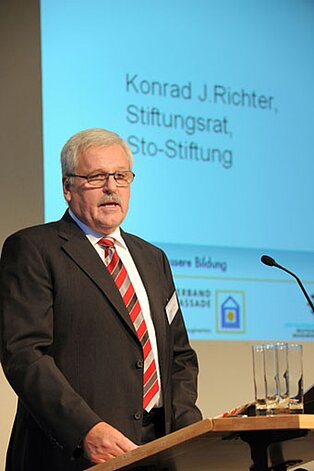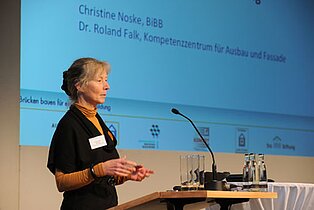Apprentice coach reduces dropout rate
Berlin. The traditional crafts are slipping into a severe talent crisis. More than 150 participants from vocational training, practice and science discussed solutions and models aiming to prevent this at the first national education congress of the plastering trade in Berlin under the motto “Building bridges for a better education”. Especially the concept of the apprentice coach marked the discussion at the conference. The event was largely financed by the Sto-Stiftung and realized in cooperation with the Kompetenzzentrum Ausbau und Fassade Rutesheim (Komzet), a competence centre for finishing and façade, and the Bundesverband (federal association) Ausbau und Fassade.
At the beginning, professor Klaus Hurrelmann, head of the current Shell Study, characterized the generation aged 12 to 25: The life planning of the youngsters is not as targeted as it used to be, dropout rates for apprenticeships are high. The building trade has to focus on the 40 per cent of adolescents whose education has gaps, who suppress problems due to social reasons, and who are prone to violence. In order to win them over, Hurrelmann concludes, the economy has to get involved more strongly and earlier in the secondary school types Haupt- and Realschule, for example by means of educational sponsorships or student companies. The building trade is still considered a “trade for those left over”, which is why targeted marketing is important.
New target groups and learning methods
Young women need to be enthused for the trade branch by emphasizing its artistic and creative aspects. They are especially important for the future of the craft since overall they show a higher readiness to qualify and develop further.
Subject-specific aptitude tests and trial internships show whether job, company and apprentice fit. But educational training must also be rethought. The participants spoke out in favour of action-oriented learning through practical projects and for a stronger link between the learning contents of the vocational school and the vocational training centres. Plasterers play a significant part in energy efficient construction, which is why further training constitutes a lifelong task for them. By means of modular additional qualifications, innovative developments such as the climate-control ceiling could occasionally be already taught in training.
The apprentice coach as mentor throughout the apprenticeship
In order to supervise the apprentice not only professionally, but also personally, Komzet developed the concept of the apprentice coach, allocating an experienced journeyman to the apprentice who will accompany them through their apprenticeship. Oliver Vana (37) of Albi plasterers in Hüfingen/Baden (Southwest Germany) has been an apprentice coach for three years and reported: “On our way to the construction site or during break time I talk to my apprentice, ask how he is, whether he has any problems. During school periods I quickly call him; I am always there for him during those times, too.” Vana uses his professional and life experience, and was also trained in three half-day seminars. Once a year he meets other coaches, exchanges experiences, because he, too, can learn something new. The informal working atmosphere is the flagship of the trades and needs to be emphasized more.
Vana currently coaches Adem Günli, an apprentice in his first year: “With his grades he had little chances of securing an apprenticeship, but during an internship he showed an iron will and successfully fought for a place.” His young mentee confidently asked those present to show more courage to implement new training concepts and stressed that a sound education is the best strategy against drugs and crime.
This way, the plastering companies in Baden, contrary to the national trend, managed to reduce the dropout rate to almost zero in three years. Konrad J. Richter, Sto-Stiftung council member responsible for the crafts, sees this as a big opportunity: “The model makes sense in other trades too, for example in painting, because the talent crisis spares no branch.”
The participants got a lot of new suggestions, but also a bunch of homework. Dr Roland Falk, head of Komzet, asked: “We must build bridges now and approach one another; the experiences of Komzet can be used nationwide. We have to make sure that the schools’ and external training centres’ impulses arrive in the every day lives of the trades. Education and training must not be neglected in the land of poets and thinkers. Especially in the crafts, all those concerned have to continuously tackle this task in the light of the impending shortage of skilled workers. The change of thinking starts today so that we can rely on competence tomorrow.”
Image 1: Contemporary teaching methods in theory and practice for lifelong learning were the focus of the conference.
Photo: Sto-Stiftung/Peter Himsel
Image 2: Adem Günli, Daniel Gemeinder and apprentice coach Oliver Vana have already proved that they can build bridges for a better education.
Photo: Sto-Stiftung/Peter Himsel
Image 3: The organizers of the conference: Uwe Koos, vice chairman of the Sto-Stiftung, Dr Roland Falk, head of Komzet, Frank Schweizer, head of the Bildungszentrum Ausbau und Fassade (education centre finishings and façade), Michael Heide, chief executive Bundesverband Ausbau und Fassade (federal association finishings and façade) and Konrad J. Richter, Sto-Stiftung council member „crafts“ (f. l. t. r.).
Photo: Sto-Stiftung/Peter Himsel















